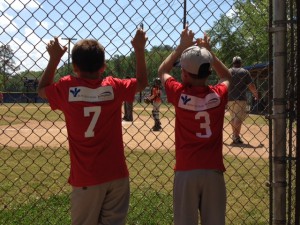Safe Practices Help Prevent Overuse Injuries for Baseball Pitchers
 As many families in South Hampton Roads head to the baseball fields this spring to watch their young players, it’s important to remember safety guidelines for pitchers to help avoid overuse injuries.
As many families in South Hampton Roads head to the baseball fields this spring to watch their young players, it’s important to remember safety guidelines for pitchers to help avoid overuse injuries.
Unfortunately, many parents and caregivers, such as grandparents, are unaware of safe pitching practices designed to prevent overuse injuries—common tears or damage that’s most often to the elbow or shoulder. As a result, young players have pain, lose play time and may develop arthritis, deformity or a disability if not treated properly, according to new research.
Between 2 and 8 percent of youth pitchers will suffer an overuse injury from throwing too hard, too often, too young, and/or without appropriate rest once pain begins in the shoulder or elbow, according to the study presented at a meeting for the American Academy of Orthopaedic Surgeons. About 38 percent of pitchers will miss at least one game because of arm pain, with 34 percent experiencing pain severe enough to warrant a doctor’s visit, the researchers found.
As the number of overuse injuries continues to rise in young baseball players, safe pitching guidelines—which focus on proper warm up exercises; maximum play time and pitch counts; recommended rest periods; appropriate ages for learning various types of pitches; and not playing on multiple teams, year round or on consecutive days—are being integrated into play at many of the nation’s 200,000 youth baseball teams, ideally with a firm, cooperative commitment from coaches, parents/caregivers and players.
“Ensuring the safety of all athletes through injury prevention is absolutely necessary, especially when it comes to youth competitors,” said University of Florida orthopaedic surgeon and lead study author Dr. Andrew Waligora.
In the study, researchers distributed and analyzed results from a 22-question survey completed by the parents of 60 youth baseball players. The content of the survey was based on recommendations provided by the USA Baseball and Medical Safety Advisory, Little League Baseball and the American Sports Medicine Institute. Sixty-one percent of the respondents identified themselves as the child’s mother. Ninety-three percent of the respondents were white, 41 percent were 41 to 50 years old, and 44 percent were the parent of a pitcher between the ages of 13 and 16.
Fifty-three percent of the parents or caregivers said they were unaware of the existence of safe pitching guidelines, 54 percent stated that they did not actively participate in monitoring their child’s pitch count, and 20 percent were unaware of how many pitches their child threw in a typical game. Among the other findings:
- Forty-nine percent of pitchers threw in more than one league at a time, and 25 percent pitched in a league more than nine months out of the year.
- Sixteen percent of the parents or caregivers surveyed did not know what kind of pitches their children threw.
- Seventy-five percent of parents or caregivers of 11- to 12-year-old players said their child threw “curveballs,” and 17 percent, “sliders.” Of those who were aware of their child throwing “breaking pitches”—curveballs, sliders, slurves or screwballs (all more advanced pitches)—18 percent reported that they learned how to throw these pitches from a parent.
- Sixty-four percent of parents or caregivers recalled their child having upper extremity pain as a direct result of pitching, 38 percent had to miss either a game or pitching because of discomfort, and 34 percent experienced pain concerning enough to be evaluated by a medical professional.
There were no significant correlations between the number of pitches typically thrown in a game, the child’s position when not pitching, number of months pitched during the year, who keeps track of pitch count, and arm pain.
“This research emphasizes the importance of caregiver participation in ensuring compliance with youth safe pitching practices,” Waligora said. “Despite the implementation and easy accessibility of safe pitching guidelines, a large portion of caregivers surveyed were unaware and/or noncompliant with these established recommendations.”
Further measures need to be taken to improve both education and compliance, the researchers said.
Injury prevention should be a multi-disciplinary approach that includes informing coaches, parents and youth pitchers about safe pitching practices,” Waligora said. “Future directions may include establishing outreach programs for the youth baseball community.”
Source: AAOS news release
+ Learn about safe baseball pitching practices at Bon Secours In Motion Physical Therapy and Sports Performance.

